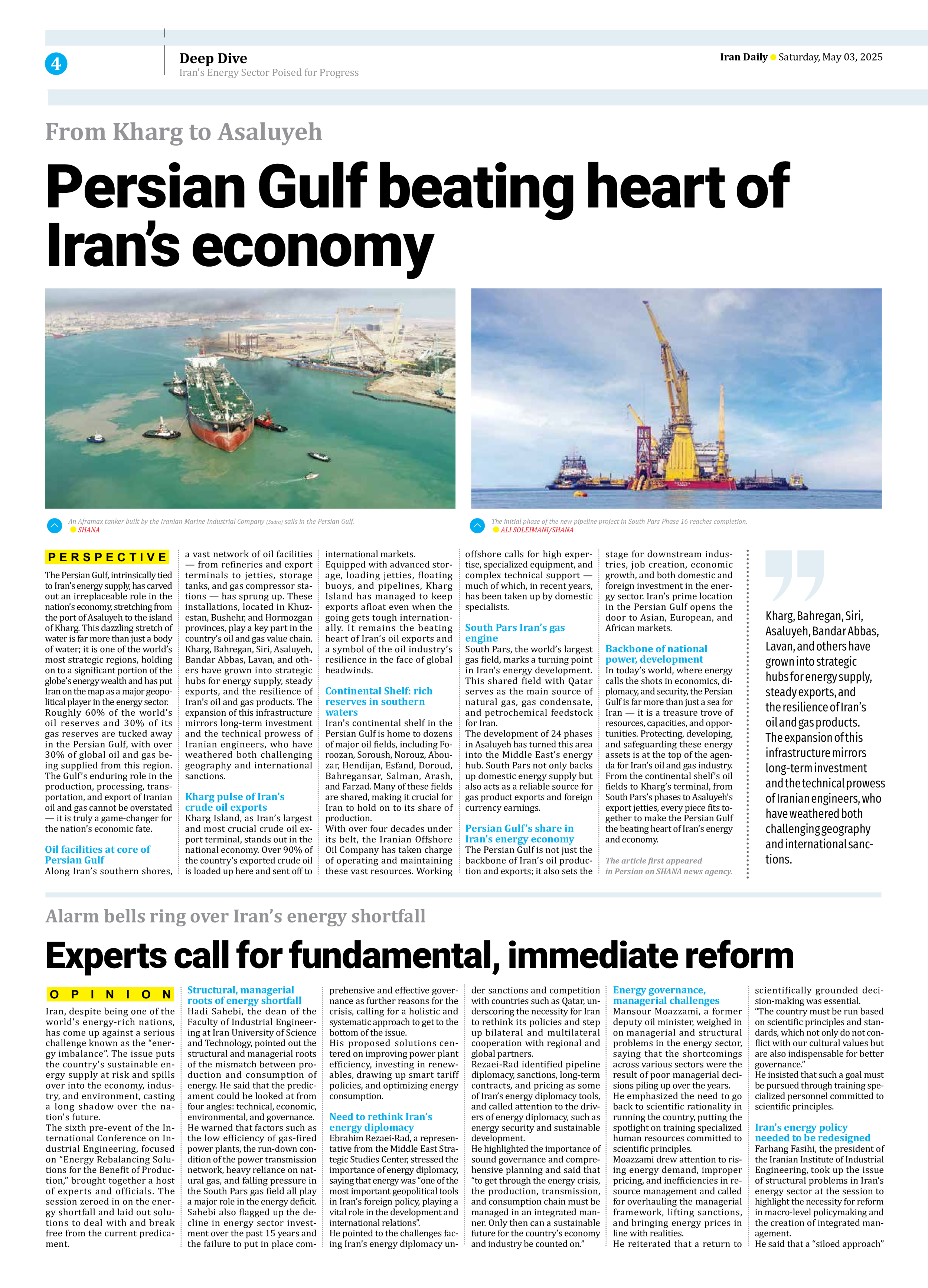
From Kharg to Asaluyeh
Persian Gulf beating heart of Iran’s economy
The Persian Gulf, intrinsically tied to Iran’s energy supply, has carved out an irreplaceable role in the nation’s economy, stretching from the port of Asaluyeh to the island of Kharg. This dazzling stretch of water is far more than just a body of water; it is one of the world’s most strategic regions, holding on to a significant portion of the globe’s energy wealth and has put Iran on the map as a major geopolitical player in the energy sector.
Roughly 60% of the world’s oil reserves and 30% of its gas reserves are tucked away in the Persian Gulf, with over 30% of global oil and gas being supplied from this region. The Gulf’s enduring role in the production, processing, transportation, and export of Iranian oil and gas cannot be overstated — it is truly a game-changer for the nation’s economic fate.
Oil facilities at core of Persian Gulf
Along Iran’s southern shores, a vast network of oil facilities — from refineries and export terminals to jetties, storage tanks, and gas compressor stations — has sprung up. These installations, located in Khuzestan, Bushehr, and Hormozgan provinces, play a key part in the country’s oil and gas value chain.
Kharg, Bahregan, Siri, Asaluyeh, Bandar Abbas, Lavan, and others have grown into strategic hubs for energy supply, steady exports, and the resilience of Iran’s oil and gas products. The expansion of this infrastructure mirrors long-term investment and the technical prowess of Iranian engineers, who have weathered both challenging geography and international sanctions.
Kharg pulse of Iran’s crude oil exports
Kharg Island, as Iran’s largest and most crucial crude oil export terminal, stands out in the national economy. Over 90% of the country’s exported crude oil is loaded up here and sent off to international markets.
Equipped with advanced storage, loading jetties, floating buoys, and pipelines, Kharg Island has managed to keep exports afloat even when the going gets tough internationally. It remains the beating heart of Iran’s oil exports and a symbol of the oil industry’s resilience in the face of global headwinds.
Continental Shelf: rich reserves in southern waters
Iran’s continental shelf in the Persian Gulf is home to dozens of major oil fields, including Foroozan, Soroush, Norouz, Abouzar, Hendijan, Esfand, Doroud, Bahregansar, Salman, Arash, and Farzad. Many of these fields are shared, making it crucial for Iran to hold on to its share of production.
With over four decades under its belt, the Iranian Offshore Oil Company has taken charge of operating and maintaining these vast resources. Working offshore calls for high expertise, specialized equipment, and complex technical support — much of which, in recent years, has been taken up by domestic specialists.
South Pars Iran’s gas engine
South Pars, the world’s largest gas field, marks a turning point in Iran’s energy development. This shared field with Qatar serves as the main source of natural gas, gas condensate, and petrochemical feedstock for Iran.
The development of 24 phases in Asaluyeh has turned this area into the Middle East’s energy hub. South Pars not only backs up domestic energy supply but also acts as a reliable source for gas product exports and foreign currency earnings.
Persian Gulf’s share in Iran’s energy economy
The Persian Gulf is not just the backbone of Iran’s oil production and exports; it also sets the stage for downstream industries, job creation, economic growth, and both domestic and foreign investment in the energy sector. Iran’s prime location in the Persian Gulf opens the door to Asian, European, and African markets.
Backbone of national power, development
In today’s world, where energy calls the shots in economics, diplomacy, and security, the Persian Gulf is far more than just a sea for Iran — it is a treasure trove of resources, capacities, and opportunities. Protecting, developing, and safeguarding these energy assets is at the top of the agenda for Iran’s oil and gas industry. From the continental shelf’s oil fields to Kharg’s terminal, from South Pars’s phases to Asaluyeh’s export jetties, every piece fits together to make the Persian Gulf the beating heart of Iran’s energy and economy.
The article first appeared
in Persian on SHANA news agency.







